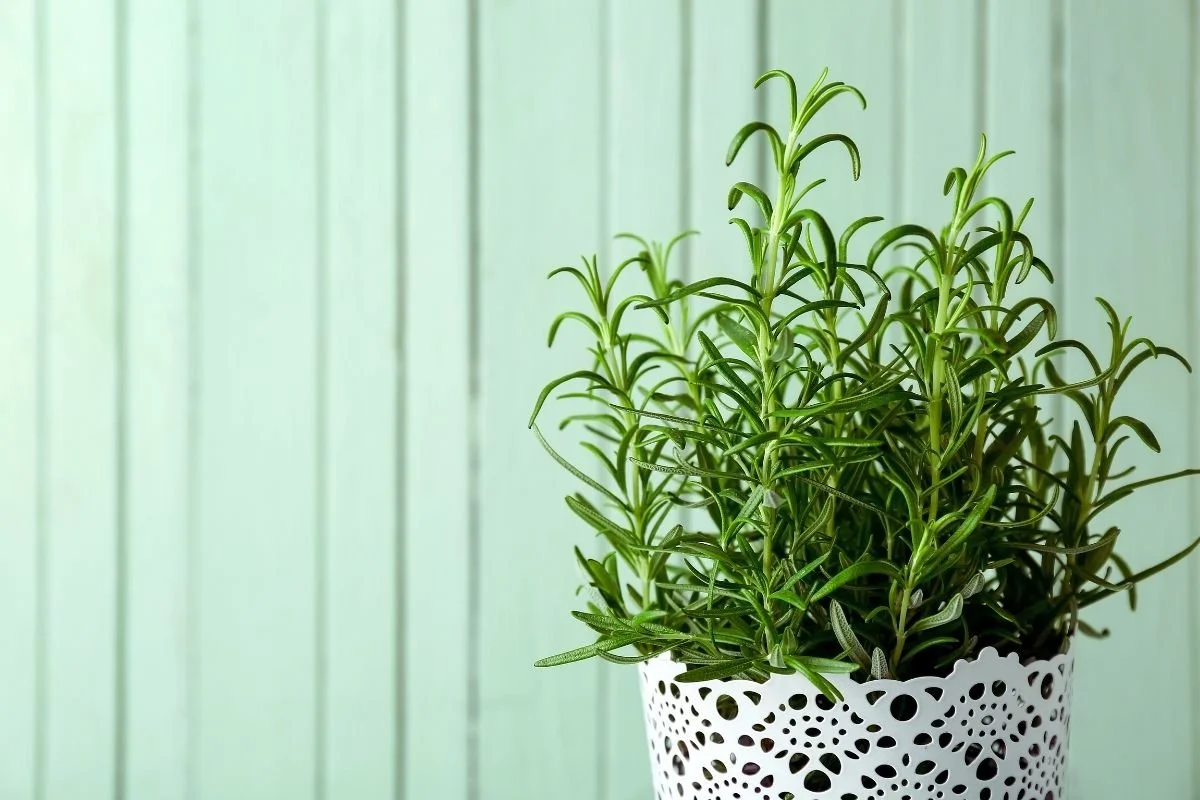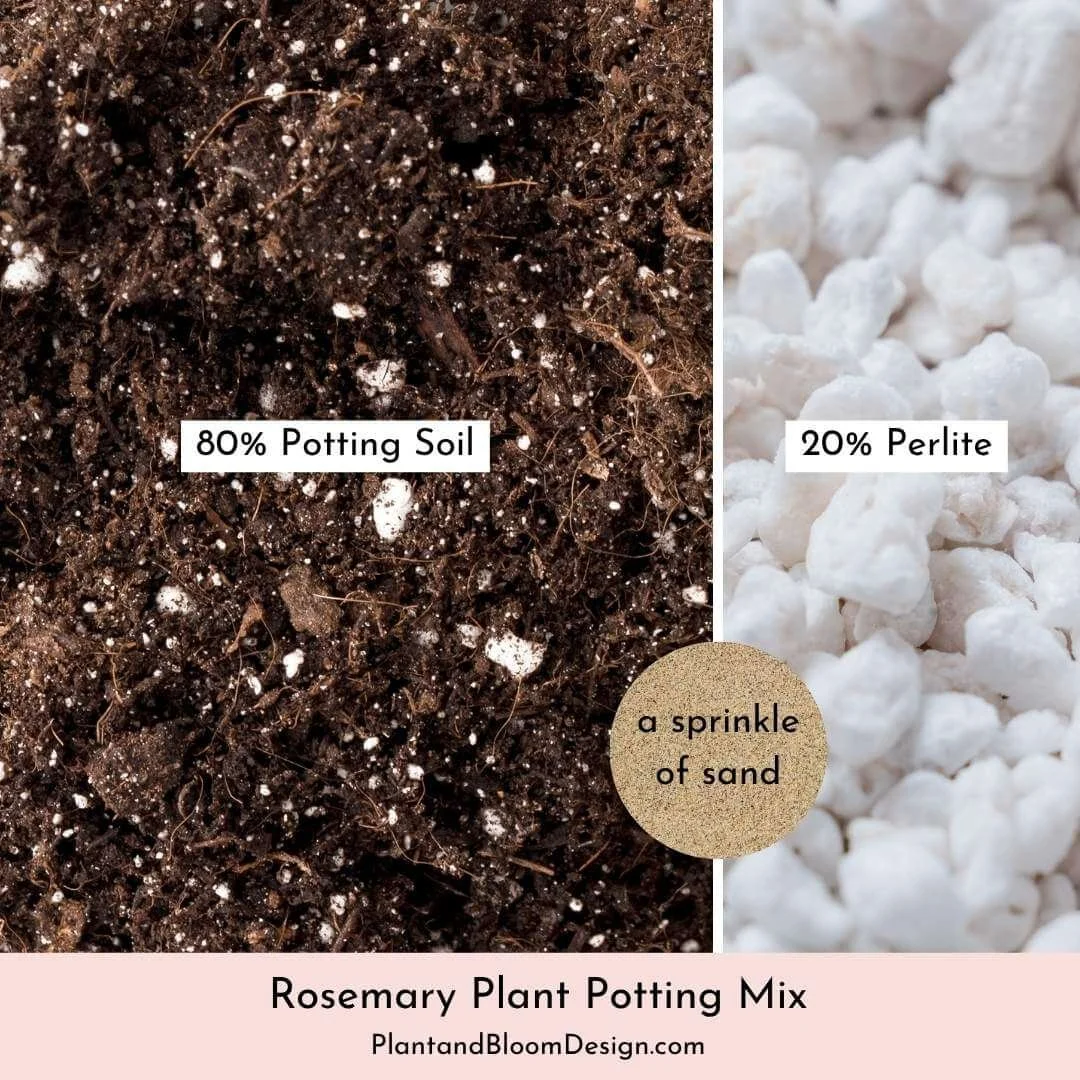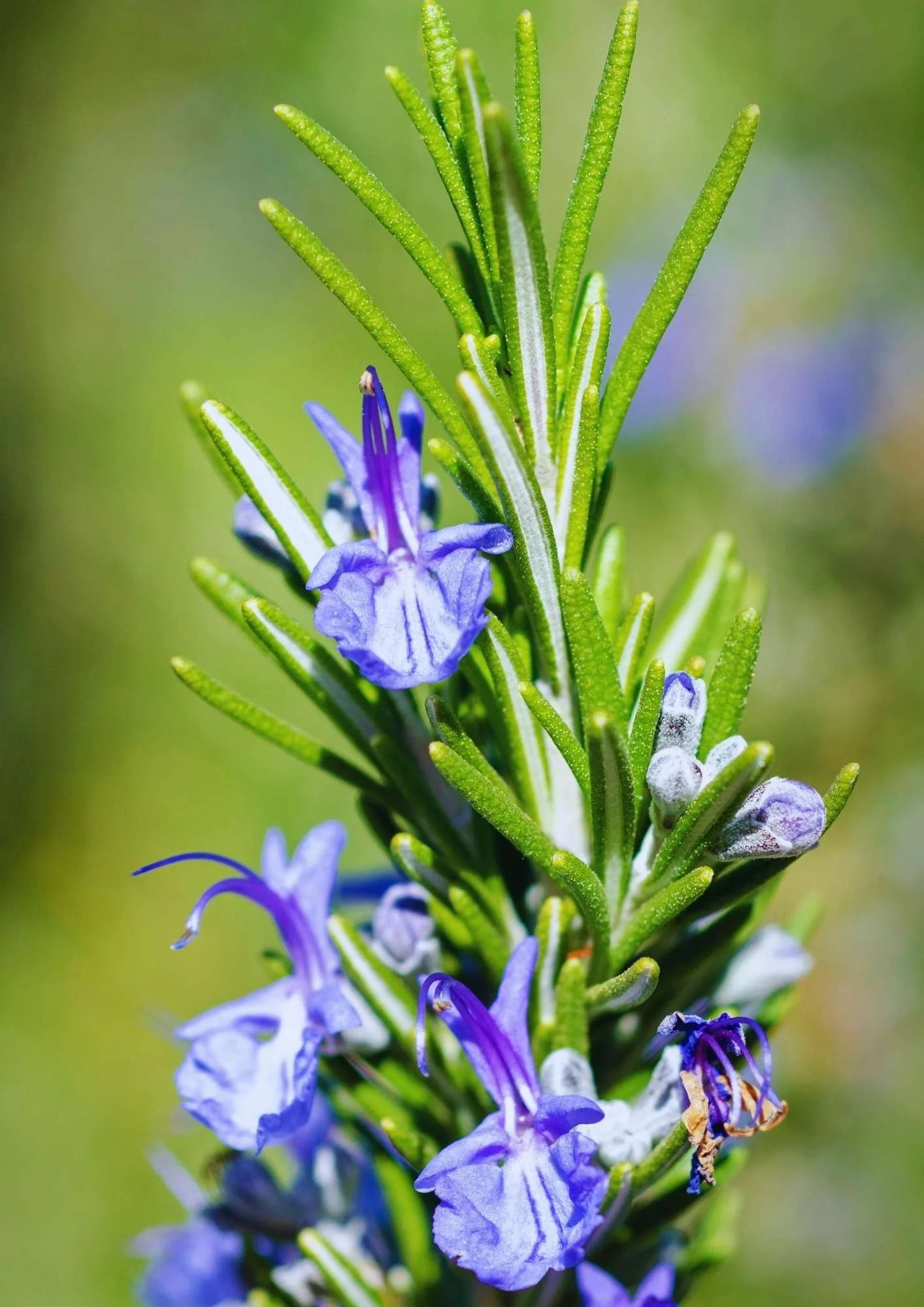Growing Rosemary Indoors: A Complete Care Guide
This post contains affiliate links, marked with an asterisk (*). As an Amazon Associate, I earn from qualifying purchases. Please see my policy on affiliate links.
Quick Answer: Growing rosemary indoors requires maximum sunlight (6-8 hours daily), well-draining soil, and careful watering only when the top inch of soil feels dry. These Mediterranean natives prefer outdoor conditions but can thrive indoors for several months with proper care. Success depends on providing bright light, good air circulation, and avoiding overwatering, the most common causes of indoor rosemary failure.
Rosemary can thrive indoors for several months with proper care! Image credit @pixelshot via Canva.com
Table of Contents
What Is Rosemary and Why Bring It Indoors?
Essential Care Requirements for Indoor Success
Common Problems and How to Solve Them
Should You Move Your Potted Rosemary Outdoors?
Pet Safety Information
Managing Expectations: The Honest Truth About Rosemary Indoors
Frequently Asked Questions
Quick Care Checklist
Expert Summary
There's something magical about reaching over to snip fresh rosemary from a plant growing right in your kitchen. That piney, aromatic fragrance instantly elevates everything from roasted potatoes to homemade focaccia, and having it at your fingertips feels like a little culinary luxury.
There's something special about harvesting your own fresh rosemary for cooking. Image credit @ildipapp via Canva.com
But here's where I need to be completely honest with you from the start: rosemary plant care indoors can be genuinely challenging. As someone who's watched countless rosemary plants struggle on windowsills over the years, I can tell you that keeping these Mediterranean beauties happy indoors requires understanding their specific needs and being realistic about what you can provide.
If you're reading this because you're wondering whether to bring your rosemary outside in the spring, you've just received one as a gift, or you're thinking about buying a rosemary plant for your kitchen, you're in exactly the right place.
Let's explore everything you need to know about successfully growing rosemary indoors, and I promise to give you the unvarnished truth along the way! 😉
What Is Rosemary and Why Bring It Indoors?
Before we dive into care instructions, understanding where rosemary comes from will give you valuable insights into what this plant actually needs to thrive.
Rosemary (Salvia rosmarinus, formerly known as Rosmarinus officinalis) is a woody, evergreen perennial herb with needle-like leaves and a distinctive aromatic fragrance. It's a member of the mint family, though you'd never guess it from looking at those tough, resinous leaves!
Rosemary's Mediterranean Origins
Here's the key to understanding rosemary: this plant is native to the dry, rocky areas surrounding the Mediterranean Sea, including coastal regions of southern Europe and North Africa.
Picture sun-baked hillsides along the Spanish coast, rocky cliffs in southern France, or the arid landscapes of North Africa. That's the environment rosemary evolved to love!
In its natural habitat, rosemary thrives in:
Full, intense sunlight
Sandy, rocky, fast-draining soil
Coastal breezes and excellent air circulation
Ambient moisture from the sea air
Hot, dry summers and mild, slightly rainy winters
Understanding these origins explains why rosemary can be tricky indoors. Your plant isn't being difficult, it's simply programmed for conditions that are very different from the average living room or kitchen!
Rosemary is native to the dry, rocky areas surrounding the Mediterranean Sea. Image credit @Petra Nesti via Canva.com.
Why Grow Rosemary Indoors
I love growing rosemary indoors, even though it's a challenging plant. In fact, I buy one every year around Thanksgiving! Despite the difficulties, there are some truly wonderful reasons why rosemary is worth the effort:
Fresh herbs at your fingertips: Nothing beats snipping fresh rosemary for cooking right when you need it. The flavor of fresh rosemary is so much better than dried, and you'll never run out mid-recipe!
Wonderful fragrance: Gently rubbing the leaves of a rosemary plant will release its piney, invigorating scent. Natural aromatherapy to lift your mood and awaken your senses!
Winter protection: If you live in zones 3-7, bringing your outdoor rosemary inside during winter might be your only option for keeping the plant alive through freezing temperatures.
Year-round harvesting: Growing rosemary indoors means you can enjoy fresh herbs even when your outdoor garden is buried under snow.
Beautiful appearance: With its upright growth habit and silvery-green needles, rosemary makes a beautiful addition to your indoor plant collection.
You can enjoy fresh herbs year-round when you grow rosemary indoors. Image credit @pixelshot via Canva.com.
Essential Care Requirements for Indoor Success
Let me paint you a familiar picture: you bring your beautiful rosemary plant indoors with the best intentions, place it on your kitchen counter where it looks absolutely perfect next to your other herbs, water it regularly, and then... within a few weeks, you notice the needles turning brown and dropping.
Sound painfully familiar? Even experienced gardeners struggle with rosemary indoors. But understanding exactly what this plant needs and what commonly goes wrong will dramatically improve your chances of success.
Light Requirements: Sunshine Is Non-Negotiable
The single biggest mistake people make when growing rosemary indoors is drastically underestimating its light requirements. I cannot emphasize this enough: rosemary needs intense, bright, direct sunlight for a minimum of 6-8 hours daily.
Think about those sunny Mediterranean hillsides where rosemary grows wild. We're talking about plants that evolved under intense sunshine with minimal shade. Your rosemary isn't being high-maintenance when it demands bright light, it's simply asking for what it needs to survive!
Best locations for rosemary indoors:
South-facing windows that receive direct sun most of the day (ideal)
West-facing windows with afternoon sun exposure
East-facing windows with strong morning light
Directly in front of glass doors or large windows
Sunny three-season porches or enclosed patios
When natural light isn't enough:
If your home simply doesn't have windows that provide 6-8 hours of direct sunlight (and many homes don't during winter months), you'll need to supplement with grow lights. This isn't optional if you want your rosemary to thrive.
Consider investing in:
Full-spectrum LED grow lights
Positioning lights 6-12 inches above the plant
Running lights for 12-14 hours daily to compensate for lower intensity
Pro tip: Your rosemary should live permanently in the brightest spot you have available. Sure, it might look charming on your dining table or kitchen island, but if those spots don't get direct sun, your plant will decline quickly. Save those locations for temporary display during dinner parties, then move your rosemary right back to its sunny window.
The Watering Balancing Act
If insufficient light is the number one killer of indoor rosemary, overwatering is a very close second. Here's the tricky part: rosemary indoors needs consistent watering but absolutely cannot tolerate soggy soil or "wet feet."
In its native Mediterranean habitat, rosemary experiences hot, dry summers with occasional rain, followed by cooler, slightly wetter winters. The key word is "slightly" - even winter rains drain quickly through rocky, sandy soil.
The golden rule for watering rosemary indoors: Water thoroughly when the top inch of soil feels dry to the touch, but never let water sit in saucers or let the soil become waterlogged.
How to water correctly:
Check soil moisture every 2-3 days by sticking your finger about an inch into the soil
If the top inch feels dry, it's time to water
Water thoroughly until water begins draining from the bottom holes
Wait for drainage to finish, then empty any water from saucers within 15-30 minutes
Never let your rosemary sit in standing water for a long period of time
Bottom watering technique:
Some gardeners find that bottom watering works beautifully for rosemary, since it encourages healthy root development and prevents water from splashing onto the foliage (which can lead to fungal issues).
Here's how to bottom water:
Place your potted rosemary in a shallow bowl, tray or container of water
Let it sit for about 20 minutes so the soil can absorb moisture from below
Remove the pot from the water
Place it in your sink to let excess water drain away completely
Return it to its sunny spot only after drainage is complete
Bottom watering lets your rosemary drink from below. Simply set the pot in a shallow bowl of water for 20 minutes, then move it to the sink to drain before returning it to its bright and sunny spot.
Seasonal watering adjustments:
During winter months when growth naturally slows, your rosemary will need less frequent watering. You might water once a week instead of twice. Always let the soil be your guide rather than following a rigid schedule.
Drainage: Absolutely Critical for Success
This point deserves its own section because it's that important: your rosemary must be planted in a pot with drainage holes. Period. No exceptions.
In the wild, rosemary grows in rocky, sandy soil that drains almost instantly. Sitting in waterlogged soil is essentially a death sentence. 😬 The roots will rot, and once root rot sets in, it's nearly impossible to save the plant.
If your rosemary came in a decorative pot without drainage:
Remove any foil or plastic wrapping immediately
Drill drainage holes in the pot, if possible
Or transplant into a proper pot with drainage holes
Use a decorative outer pot (cachepot) if desired, but keep the plant in an inner plastic nursery pot with holes and always remove it to water
Soil Requirements: Well-Draining Is Essential
Rosemary thrives in what gardeners call "lean" soil - meaning it's not particularly rich in organic matter or nutrients. This might seem counterintuitive, but remember that rosemary evolved in nutrient-poor, rocky Mediterranean soil.
Ideal soil characteristics for rosemary indoors:
Fast-draining potting mix
Slightly alkaline to neutral pH (6.5-7.5)
Sandy or gritty texture that doesn't hold excess moisture
Low in heavy organic matter
Creating the perfect mix:
If you're repotting or starting fresh, consider mixing:
80% indoor potting soil
20% perlite
Optional: small amount of sand for extra drainage
Avoid heavy, moisture-retaining mixes and anything labeled "moisture control" since these are the opposite of what rosemary needs!
Humidity and Air Circulation
Here's something that confuses many gardeners: despite coming from Mediterranean regions, rosemary actually appreciates some humidity when grown indoors. This seems counterintuitive for a plant from a hot, dry climate, but the key is pairing that humidity with excellent air circulation.
In coastal Mediterranean areas, rosemary experiences:
Humidity from sea breezes
Constant air movement
Quick-drying conditions after rain or dew
Creating the right environment indoors:
Provide good air circulation by opening windows as weather permits or running fans
Avoid placing rosemary in stagnant, stuffy rooms
Consider placing a pebble tray with water nearby to add slight humidity to the air
Avoid these locations:
Near heating vents that blow hot, dry air directly on the plant
Inside terrariums, cloches or tabletop greenhouses
In bathrooms with high humidity and poor light
Temperature: Cooler Than You Think
Most people assume that because rosemary comes from the Mediterranean, it loves consistently warm temperatures. Not quite! While rosemary does enjoy warmth during the day, it actually prefers cooler conditions at night and during winter months.
Ideal temperature range:
Daytime: 65-75°F
Nighttime: 55-65°F (cooler temperatures are actually beneficial)
Winter: Can tolerate temperatures down to 30-40°F for short periods of time
Best indoor locations:
Cool, bright windowsills (often naturally cooler than room temperature)
Unheated sunrooms with abundant light
Three-season porches that stay above freezing
Bedrooms or other rooms that stay naturally cooler
Avoid these spots:
Next to radiators, heating vents, or fireplaces
In consistently warm rooms (above 75°F)
Areas with hot afternoon sun but poor ventilation
Near drafty doors or windows that let in freezing air
Fertilizing: A Light Touch
Here's some good news amid all these requirements: rosemary doesn't need heavy fertilizing! In fact, over-fertilizing can cause excessive, weak growth that's more susceptible to problems and less flavorful for cooking.
Fertilizing schedule for rosemary indoors:
Feed once every 4-6 weeks during spring and summer (active growing season)
Use a balanced liquid fertilizer (like 20-20-20) diluted to half strength
Skip fertilizing entirely during fall and winter months
Never fertilize a stressed, struggling, or newly transplanted plant
Signs you're fertilizing correctly:
Steady, moderate new growth
Strong aromatic scent
Healthy green color on needles
Signs of over-fertilizing:
Excessive leggy growth
Reduced fragrance
Yellowing needles
Salt buildup (white crust) on soil surface
Easy does it! Rosemary doesn’t need heavy fertilizing. Image credit @ BigC Studio via Canva.com
Common Problems and How to Solve Them
Even with careful attention, you'll likely encounter some challenges when growing rosemary indoors. Let's troubleshoot the most common issues so you know exactly what to do when problems arise.
Problem #1: Needles Turning Brown and Dropping
This is probably the most common complaint about rosemary indoors, and it can be caused by several different issues.
Most likely causes:
Overwatering and poor drainage leading to root rot
Underwatering and complete soil dryness
Insufficient light
Shock from environmental changes
Poor air circulation leading to fungal issues
Solutions:
Check soil moisture immediately - if soggy, stop watering and improve drainage
If bone dry, water thoroughly and establish a more consistent schedule
Move to the brightest location possible
Improve air circulation around the plant
Remove brown needles to prevent spread of potential disease
Be patient - rosemary can take several weeks to recover from stress
Problem #2: Plant Looks Leggy and Sparse
If your rosemary is stretching toward the light with long gaps between needle clusters, that's a clear sign of insufficient light.
Cause: The plant is literally reaching and stretching toward any available light source in a desperate attempt to photosynthesize.
Solutions:
Move immediately to a brighter location
Supplement with grow lights if necessary
Prune back leggy growth by about one-third to encourage bushier growth (only do this if the plant is otherwise healthy)
A healthy rosemary plant has bright green needles on top with a silvery sheen underneath. Image credit @GPimages via Canva.com
Problem #3: Powdery White or Gray Substance on Needles
This is likely powdery mildew, a fungal disease that thrives in conditions with poor air circulation and high humidity.
Solutions:
Improve air circulation immediately with a small fan
Avoid getting water on the needles
Remove and dispose of affected growth
Reduce humidity while maintaining good air movement
Ensure your plant has adequate spacing from other plants
Problem #4: Entire Plant Wilting Despite Moist Soil
This is a serious sign that often indicates root rot, usually from overwatering or poor drainage.
What to do:
Check roots by gently removing the plant from its pot
Healthy roots are white or light-colored; rotted roots are brown, black, mushy, and smell bad
If rot is present, trim away affected roots with clean scissors
Repot in fresh, well-draining soil in a clean pot
Reduce watering frequency significantly
Understand that recovery is possible but not guaranteed 😬
Problem #5: New Growth Is Pale or Yellowish
Possible causes:
Insufficient light
Nutrient deficiency
Overwatering
Soil pH issues
Solutions:
Maximize light exposure
If light is adequate, try a light feeding with diluted fertilizer
Check soil drainage and adjust watering
Consider repotting if the plant has been in the same soil for over a year
Should You Move Your Potted Rosemary Outdoors?
If you're growing rosemary in a pot indoors, you're probably wondering about two things: Can I move this pot outside during warmer months? And should I plant it in the ground permanently?
Let me address both questions, because the answers depend on your climate and your goals for the plant.
Moving Your Potted Rosemary Outdoors Seasonally
This is actually one of the best strategies for keeping rosemary healthy! Many gardeners find that moving potted rosemary outdoors during spring, summer, and fall - then bringing it back inside for winter - gives the plant the best of both worlds.
The benefits of seasonal outdoor time:
Your rosemary gets the intense, full-spectrum sunlight it craves
Natural air circulation and day/night temperature fluctuations promote healthy growth
The plant can truly thrive during the growing season
You bring it back indoors refreshed and vigorous for winter
When to move your pot outdoors: After all danger of frost has passed in spring, typically when nighttime temperatures stay consistently above 50°F
When to bring it back inside: Before nighttime temperatures dip below 50°F consistently
Transition tips:
Start by placing the pot outdoors for a few hours daily, gradually increasing exposure over 7-10 days
Choose a partly sunny, protected location initially, then move to full sun
Monitor soil moisture carefully - outdoor conditions dry soil faster than indoors
Understanding Your Hardiness Zone
Before deciding whether to plant your rosemary in the ground permanently, you need to know your USDA hardiness zone. You can find this on the USDA Plant Hardiness Zone Map.
Zone 8-10: Your potted rosemary can be planted in the ground and survive year-round outdoors. However, you still need to protect it during unusually severe winters with prolonged freezing temperatures.
Zone 7: This is a borderline zone. Most rosemary varieties cannot survive zone 7 winters in the ground without winter protection, though cold-hardy cultivars like 'Arp' and 'Madeline Hill' may succeed. Even then, a severe winter can kill your plant.
Zone 6: Most rosemary varieties cannot survive winter outdoors in zone 6 and must be brought indoors before the first frost. However, a few cold-hardy cultivars like 'Arp' and 'Madeline Hill' can survive zone 6 winters planted in the ground with heavy protection (mulching, wrapping, and a protected location).
Zone 5 and colder: Your rosemary cannot survive winter outdoors, whether in a pot or in the ground. You must bring potted plants indoors before the first frost if you want to keep the plant alive.
Should You Plant Your Rosemary in the Ground?
If you live in zones 8-10, planting rosemary in the ground can work beautifully! It will become a permanent part of your landscape and can grow quite large over time, and may even flower. However, there are important considerations:
Advantages of keeping rosemary in a pot:
Complete flexibility to bring it indoors during bad weather
Ability to move it to the sunniest spot seasonally
Easy to protect from prolonged freezing or excessive winter moisture
No risk of losing an established plant to an unexpectedly harsh winter
If you decide to plant in the ground (zones 8-10 only):
Choose a location with full sun and excellent drainage
Plant in a raised bed or on a slope if your soil holds moisture
Avoid low spots where cold air settles or water collects
Be prepared to provide protection during unusually severe weather
Accept that even in "hardy" zones, exceptionally cold winters can kill rosemary
When grown outdoors, rosemary may surprise you with delicate purple blooms! Image credit @NNehring via Canva.com
Pet Safety Information
Before we continue, there's an important safety issue you need to know about: while the rosemary plant itself is safe for pets, rosemary essential oil is not.
Is Rosemary Toxic to Pets?
The ASPCA lists rosemary plants as non-toxic to dogs, cats, and horses in their database of poisonous plants. Your pet nibbling on your rosemary plant is generally not a cause for alarm. However, rosemary essential oil is a different story entirely. It can be toxic to pets and should be kept completely away from them.
Potential concerns with the plant:
Large amounts can cause mild gastrointestinal upset in dogs and cats
Some pets may have individual sensitivities
Ingesting woody stems can cause choking or digestive blockage
Important note about essential oils: Rosemary essential oil is concentrated and can be harmful to pets, especially cats. Never apply rosemary oil to your pets or diffuse it in areas where they spend time.
Signs of rosemary overconsumption in pets:
Vomiting
Diarrhea
Drooling
Loss of appetite
Lethargy
Immediate action: If your pet has consumed a large amount of rosemary, shows concerning symptoms, or has been exposed to rosemary essential oil, contact your veterinarian or the ASPCA Animal Poison Control Center (888-426-4435).
Managing Expectations: The Honest Truth About Rosemary Indoors
Rosemary is a beautiful, fragrant, useful plant that's absolutely worth growing indoors! But it's important to have realistic expectations about what "success" looks like.
Here's the honest truth: rosemary isn't naturally suited for permanent indoor life. While you can definitely grow it indoors and enjoy it for months at a time, treating it as a seasonal indoor plant or rotating it between indoor and outdoor locations often yields the happiest, healthiest results.
Why Rosemary Indoors Is Challenging
Environmental factors working against you:
Most homes simply don't provide enough natural light, especially in the winter
Indoor heating systems create dry air
Consistent indoor temperatures don't allow for the day/night temperature fluctuations rosemary prefers
Limited air circulation compared with outdoor conditions
Plant factors to consider:
Rosemary is genetically programmed for intense Mediterranean sunlight
Its natural growth cycle doesn't align well with indoor conditions
The plant is a woody perennial shrub, not a true "houseplant"
It thrives with seasonal changes in temperature and light that indoor environments can't replicate
Setting Realistic Goals
Rather than expecting permanent indoor success, consider these more achievable goals:
Short to medium-term enjoyment (3-6 months): This is absolutely realistic and completely worthwhile! Enjoy fresh herbs, wonderful fragrance, and the satisfaction of growing your own food indoors during this time.
Seasonal indoor care: Bring rosemary indoors for winter protection in cold climates, then move it back outdoors for spring through fall. This is actually one of the most successful strategies for long-term plant health.
Frequently Asked Questions About Growing Rosemary Indoors
How often should I water rosemary indoors?
Water when the top inch of soil feels dry to the touch, typically every 4-7 days depending on your home's temperature, humidity, and light conditions. Always check soil moisture rather than following a rigid schedule, since watering needs vary significantly with season and environment.
Why is my indoor rosemary turning brown?
Brown needles usually indicate either overwatering (leading to root rot) or underwatering (letting soil become completely dry). Other causes include insufficient light, poor air circulation, or environmental stress from recent changes. Check soil moisture, improve light exposure, and ensure good drainage.
Can rosemary survive winter indoors?
Yes, rosemary can survive winter indoors if you provide adequate light (6-8 hours of direct sun or grow lights), proper watering, and good air circulation. However, it's more accurate to say rosemary "survives" rather than "thrives" indoors. The plant will do best if moved back outdoors once warm weather returns.
How do I know if my rosemary is getting enough light?
Signs of adequate light include compact, bushy growth, dark green needles, strong aromatic scent when touched, and possibly small flowers. Signs of insufficient light include pale needles, leggy growth with long gaps between leaves, weak fragrance, and leaning heavily toward the light source.
Should I prune my indoor rosemary?
Light pruning is beneficial and can be combined with harvesting for cooking. Remove the tips of stems to encourage bushier growth, and trim any dead or damaged growth. However, avoid heavy pruning on stressed plants, and never remove more than one-third of the plant at once.
Can I grow rosemary indoors from seed?
While possible, growing rosemary from seed is a very slow process and has low success rates. Seeds take a long time to germinate and require specific conditions. Starting with a nursery plant or rooting a cutting from an existing plant is much more practical for indoor growing.
Why won't my rosemary plant bloom indoors?
Insufficient light is the primary reason rosemary doesn't flower indoors. Rosemary needs very bright, direct sunlight to produce its small purple flowers. Even with perfect care, indoor rosemary blooms much less reliably than outdoor plants. Focus on keeping the foliage healthy rather than expecting abundant flowers indoors.
How long can rosemary live indoors?
With excellent care and ideal conditions, rosemary can live indoors for 6 months or more before typically needing outdoor recovery time. Some gardeners successfully keep rosemary indoors longer, but plants generally perform best with at least some time outdoors during warm months. The seasonal indoor/outdoor rotation strategy often produces the healthiest, longest-lived plants.
Quick Care Checklist for Rosemary Indoors
Daily Tasks
Check soil moisture level (finger test)
Ensure plant is receiving maximum available light
Monitor for any signs of stress or pests
Weekly Tasks
Water thoroughly when top inch of soil is dry
Rotate plant 180 degrees for even light exposure
Remove any dead or browning needles
Check that drainage saucers are empty
Monthly Tasks
Fertilize during spring and summer only (every 4-6 weeks)
Seasonal Tasks
Spring: Begin light fertilizing, plan outdoor transition if applicable, increase watering frequency as growth resumes
Summer: Monitor for increased water needs, consider moving outdoors, harvest more actively if plant is thriving
Fall: Prepare for reduced growth, stop fertilizing, bring outdoor plants inside before frost
Winter: Maximize available light, reduce watering frequency, accept slower growth, maintain cooler nighttime temperatures if possible
Success Indicators vs. Warning Signs
✅ Signs Your Rosemary Is Thriving Indoors
New growth appearing at stem tips
Strong, piney fragrance when needles are touched
Compact, bushy growth habit without excessive legginess
Needles maintaining healthy dark green color
No significant needle drop
Plant appears sturdy and upright
🚨 Warning Signs That Need Immediate Attention
Needles turning brown or gray and dropping off
Leggy, stretched growth with long gaps between needles
Weak fragrance
Wilting despite adequate soil moisture (possible root rot)
Yellowing needles
Powdery white or gray coating on needles
Entire branches dying back
Expert Summary: Mastering Rosemary Plant Care Indoors
Successfully growing rosemary indoors requires replicating Mediterranean conditions as closely as possible: intense sunlight, excellent drainage, careful watering practices, and good air circulation.
Key takeaways for success:
Maximize light exposure – This is the single most important factor. Insufficient light is the primary cause of indoor rosemary failure.
Master the watering balance – Water when the top inch of soil is dry, but never let it become waterlogged or bone dry.
Ensure perfect drainage – Pots must have drainage holes, and soil should be fast-draining and slightly sandy.
Provide good air circulation – Avoid stuffy rooms and use a fan if possible.
Set realistic expectations – Treating rosemary as a seasonal indoor/outdoor plant or temporary indoor plant often yields the best results.
Remember that even experienced gardeners find rosemary challenging to keep thriving indoors permanently. If you successfully grow rosemary indoors for several months and then transition it outdoors, or bring it in only for winter protection, you're using excellent plant care strategies!
The rewards of growing rosemary indoors - fresh herbs for cooking, wonderful fragrance, and the satisfaction of nurturing this beautiful Mediterranean plant - make the effort absolutely worthwhile.
Give yourself credit for every week your rosemary stays healthy and fragrant indoors👏. You're providing real value to your cooking, your home environment, and your own gardening skills - and that's something to celebrate!
Happy growing 😃🪴
Follow Plant and Bloom Design Studio for More Ideas!














